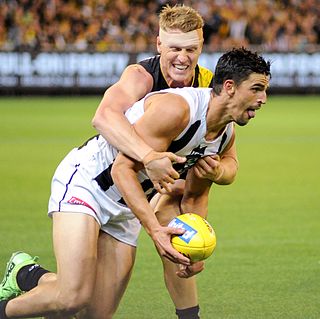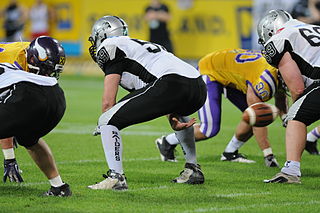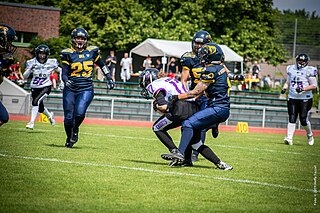Related Research Articles

Canadian football, or simply football, is a sport in Canada in which two teams of 12 players each compete on a field 110 yards (101 m) long and 65 yards (59 m) wide, attempting to advance a pointed oval-shaped ball into the opposing team's end zone.
In gridiron football, not all players on offense are entitled to receive a forward pass: only an eligible pass receiver may legally catch a forward pass, and only an eligible receiver may advance beyond the neutral zone if a forward pass crosses into the neutral zone. If the pass is received by a non-eligible receiver, it is "illegal touching". If an ineligible receiver is beyond the neutral zone when a forward pass crossing the neutral zone is thrown, a foul of "ineligible receiver downfield" is called. Each league has slightly different rules regarding who is considered an eligible receiver.

Most forms of football have a move known as a tackle. The primary purposes of tackling are to dispossess an opponent of the ball, to stop the player from gaining ground towards goal or to stop them from carrying out what they intend.

A snap is the backward passing of the ball in gridiron football at the start of play from scrimmage.

Gridiron football, also known as North American football, or in North America as simply football, is a family of football team sports primarily played in the United States and Canada. American football, which uses 11 players, is the form played in the United States and the best known form of gridiron football worldwide, while Canadian football, which uses 12 players, predominates in Canada. Other derivative varieties include arena football, flag football and amateur games such as touch and street football. Football is played at professional, collegiate, high school, semi-professional, and amateur levels.
This is a glossary of terms used in Canadian football. The Glossary of American football article also covers many terms that are also used in the Canadian version of the game.
- Legally positioned at the kick-off or the snap. On kick-offs, members of the kicking team must be behind the kick-off line; members of the receiving team must be at least 10 yards from the kick-off line. On scrimmages, at the snap the offence must be behind the line of scrimmage; the defence must be at least one yard beyond the line of scrimmage.
- A player of the kicking team who can legally recover the kick. The kicker and any teammates behind the ball at the time of the kick are onside. Thus on kick-offs all players of the kicking team are onside, but on other kicks usually only the kicker is. The holder on a place kick is not considered onside.
- A defensive position on scrimmages, also called free safety. Typical formations include a single safety, whose main duty is to cover wide receivers. See also defensive back.
- A two-point score. The defence scores a safety when the offence carries or passes the ball into its own goal area and then fails to run, pass, or kick the ball back into the field of play; when this term is used in this sense, it is also referred to as a safety touch.

American and Canadian football are gridiron codes of football that are very similar; both have their origins partly in rugby football, but some key differences exist between the two codes.
In American and Canadian gridiron football, pass interference (PI) is a foul that occurs when a player interferes with an eligible receiver's ability to make a fair attempt to catch a forward pass. Pass interference may include tripping, pushing, pulling, or cutting in front of the receiver, covering the receiver's face, or pulling on the receiver's hands or arms. It does not include catching or batting the ball before it reaches the receiver. Once the ball touches any defensive player or eligible offensive receiver, the above rules no longer apply and the defender may tackle the receiver or attempt to prevent them from gaining control of the ball. Once a forward pass is in the air it is a loose ball and thus any eligible receiver – all defensive players are eligible receivers – may try to catch it. When a defensive player catches a forward pass it is an interception and their team gains possession of the ball. Some actions that are defined as pass interference may be overlooked if the defender is attempting to catch or bat the ball rather than focusing on the receiver.
In ice hockey, a play is offside if a player on the attacking team does not control the puck and is in the offensive zone when a different attacking player causes the puck to enter the offensive zone, until either the puck or all attacking players leave the offensive zone. Simply put, the puck must not enter the attacking zone after attacking players. If a player on the attacking team is in the offensive zone before the puck, either an immediate offside occurs, or they must retreat to the neutral zone.

Gameplay in American football consists of a series of downs, individual plays of short duration, outside of which the ball is dead or not in play. These can be plays from scrimmage – passes, runs, punts or field goal attempts – or free kicks such as kickoffs and fair catch kicks. Substitutions can be made between downs, which allows for a great deal of specialization as coaches choose the players best suited for each particular situation. During a play, each team should have no more than 11 players on the field, and each of them has specific tasks assigned for that specific play.

In gridiron football, an official is a person who has responsibility in enforcing the rules and maintaining the order of the game.
A formation in American football refers to the position players line up in before the start of a down. There are both offensive and defensive formations and there are many formations in both categories. Sometimes, formations are referred to as packages.

In sports, a false start is a disallowed start, usually due to a movement by a participant before being signaled or otherwise permitted by the rules to start. Depending on the sport and the event, a false start can result in a penalty against the athlete's or team's field position, a warning that a subsequent false start will result in disqualification, or immediate disqualification of the athlete from further competition.

High school football is gridiron football played by high school teams in the United States and Canada. It ranks among the most popular interscholastic sports in both countries, but its popularity is declining, partly due to risk of injury, particularly concussions. According to The Washington Post, between 2009 and 2019, participation in high school football declined by 9.1%. It is the basic level or step of tackle football.
An official in Canadian football is a person who has responsibility in enforcing the rules and maintaining the order of the game, like their counterparts in the American game. In the Canadian Football League, seven officials operate on the field. Lower levels of play up to the university level use less than the standard seven.
The following terms are used in American football, both conventional and indoor. Some of these terms are also in use in Canadian football; for a list of terms unique to that code, see Glossary of Canadian football.

In gridiron football, a penalty is a sanction assessed against a team for a violation of the rules, called a foul. Officials initially signal penalties by tossing a bright yellow colored penalty flag onto the field toward or at the spot of a foul.

Offside is a minor foul in gridiron football caused when a player crosses the line of scrimmage ahead of the snap of the ball. The penalty associated with the infraction is the advancing of the ball five yards and a replay of the down.

In gridiron football, a punt is a kick performed by dropping the ball from the hands and then kicking the ball before it hits the ground. The most common use of this tactic is to punt the ball downfield to the opposing team, usually on the final down, with the hope of giving the receiving team a field position that is more advantageous to the kicking team when possession changes. The result of a typical punt, barring any penalties or extraordinary circumstances, is a first down for the receiving team. A punt is not to be confused with a drop kick, a kick after the ball hits the ground, now rare in both American and Canadian football.
References
- ↑ Beacom, Mike (3 August 2010). The Complete Idiot's Guide to Understanding Football. ISBN 9781101458785.
- ↑ NIRSA (20 March 2009). 2009 & 2010 NIRSA Flag & Touch Football Rules Book & Officials' Manual-14th ... p. 39. ISBN 9780736081139.
- ↑ 2016 and 2017 NCAA Football Rules and Interpretations. NCAA. 2016. pp. FR-34.
- ↑ Long, Howie; Czarnecki, John (12 May 2011). Football for Dummies. pp. 42–43. ISBN 9781118012659.